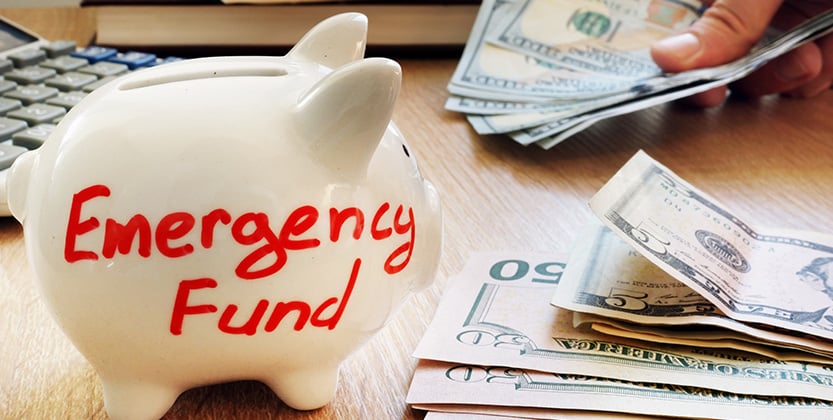
8 Tips For Starting an Emergency Fund
What would you do if you suddenly lost your job today, or have fallen ill for a couple of weeks and you’re not able to go to work? What if you find out that you urgently need to repair the leaking pipes in your basement or replace a portion of your roof after a storm?
The truth is this: we will all encounter an urgent, unexpected expense at one point or another. No matter how prepared we feel, life will always surprise us in unexpected ways.
But another sad truth: Americans don’t have enough money set aside for emergencies.
According to a survey conducted by GoBanking Rates, it was found out that more than half of the respondents say they don’t have enough to cover emergency expenses. Furthermore, the survey revealed that 38% of the respondents say that they have $1,000 or less to tide them through unexpected job loss.
Sadder still, the survey also reports that almost 50% of the respondents don’t have more than $1,000 set aside for medical emergencies. If you must know, medical debt is the leading cause for bankruptcy in the country.
What all these data tell us is that many of us are financially unprepared for emergencies and too often, these unexpected expenses cause us to plunge deeper into debt.
This is the main reason why all us need an emergency fund. You want to save money so you can easily solve an urgent expense without messing up your budget and going into debt.
WHAT IS AN EMERGENCY FUND?
An emergency fund is a specialized saving earmarked for emergencies. It is the money you use for when you suddenly need to go to the ER, have your home or car fixed and cover unexpected bills. Importantly, the emergency fund is essential to tide you over bouts of unemployment.
The emergency fund is an essential part of your financial plan. Having an emergency fund gives you the assurance that you wouldn’t have to go into debt or excessively use your credit card for unplanned expenses.
As life is unexpected, the emergency fund is your plan in planning for the unexpected.
HOW TO START SAVING FOR AN EMERGENCY FUND
If you want peace of mind, you cannot not have an emergency fund. For some people, it may seem daunting to save a couple of thousand dollars and not use it for things like vacations and entertainment. Here’s the thing, you want to build an emergency fund and wish that you never have to use it. But it’s good to know that when an emergency strikes, you have the money right there to use.
Therefore, you need to make saving an emergency fund a non-negotiable until you’ve saved an adequate amount that you’re comfortable with.
Figure out your emergency fund total
How much do you need in an emergency fund? The answer depends on who you ask, and the decision is entirely up to you. According to most experts, you need to have at least three months’ worth of expenses. To get the figure, add all the basic necessities like food, housing, transportation, utilities, insurance, and debt payments each month. Multiply the amount by three and that should be the emergency fund you need to aim for.
But are you comfortable with just a three-month emergency fund? According to some experts, you need to save at least six months’ worth of expenses so that you have enough funds to live with as you get back on your feet. For instance, if you lost your job and was unable to find new work in three months, your emergency fund would have run out at the start of the fourth month. If you’re able to find a job on your fourth or fifth month and you’ve used up all the funds, it is very likely that you’ll go into debt.
Some experts even recommend an even higher amount. Suze Orman, for instance, believes that you should aim for an eight-month emergency fund. Apart from losing your job, there are several other things that can happen: rushing a family member to the ER, getting a costly speeding ticket, needing repairs on your cars and so on. All of these things can easily eat away at your fund, so the bigger you have sacked away, the better.
Of course, the circumstances can be different from person to person. If you’re single and don’t have a family to feed, your food expenses might be lower. If you live near work, your transportation expenses might be lesser than colleagues doing a 40-minute commute. To get the ideal amount, sit down with all your basic monthly expenses and ask this question: how much do I need to sleep soundly at night?
Set a monthly goal
You probably think that your emergency fund is way too huge to save on one go. You’re right. That’s why you need to save for an emergency fund in small increments, at least initially.
Sit down with your budget and see how much you can wiggle for an emergency fund. If you can only do $30, $50 or $100 for now, that’s alright. What’s important is that you’re starting to save and you’re committed not to touch this savings unless very necessary. Over time, your emergency fund should grow. Before you know it, you have saved a good enough amount for emergencies.
But don’t stop there. If you’re done paying a debt, you can increase your contributions towards an emergency fund. There may be months when your business is doing exceptionally great and times when you’ve earned a hefty bonus at work. Throw a good chunk of that money towards the emergency fund. Take advantage of every financial opportunity to grow the fund. Otherwise, you can stick with your monthly goal and use that as momentum to keep saving.
Set a budget
The budget is perhaps the holy grail for any financial plan. Set a budget and designate savings for the emergency fund as part of your expenses. That way, you’ll always remember to save for it from every paycheck.
But not only that, you need to budget for all your expenses so you got everything covered. Without a budget, it’s easy to spend money mindlessly, only to find out that you don’t have enough money until your next paycheck. It wouldn’t be so surprising if you need to borrow or take high-interest cash advances just to get you through the rest of the days. And when there’s an emergency, the situation worsens.
If your budget currently doesn’t have allocation for the emergency fund, it’s about time you make some changes to it.
Cut back on expenses
You can significantly increase your emergency savings monthly contribution by cutting back on expenses. You might still be paying for memberships and subscriptions you so rarely use. And if you come to think of it, it’s just a waste of money. That would have been a good enough amount to beef up your emergency fund.
Looking at your budget, you might still find a couple of ways to reduce spending. You may opt to carpool with a colleague some days to save on gas. You might want to switch to cheaper and generic brands. You could even use coupons and discount codes to reduce your grocery expenses.
And if you want to be more radical and drastic about it, consider getting a roommate to reduce your housing costs. Cook your own meals and brown bag them at work. You could even sacrifice your clothing and entertainment expenses for a while just so you could build your emergency fund more quickly.
There are many creative ways to cut back on expenses. What’s important is that you put this “extra” money to good use, specifically in growing your emergency fund.
Get a second job
You know you can only cut back on expenses so far. When you’ve reached the bare bones of your budget, you can’t reduce it any further. However, there are several ways to increase your income, and this can be a lucrative way to build your emergency fund.
If you can’t put extra hours at work, consider working on your passion project that can bring in some money. You can put your photography skills at work by taking in clients in the weekend and the holidays. You could also sign up for Uber or Grab and drive on your days off. You could even sell your products online, such as baked good and crafts. Dog walking, babysitting, and house cleaning are also possible side jobs you can take to boost your income.
Sell things you aren’t using
Take a good look around and see what you can sell and generate extra money from. Perhaps you can sell clothes, furniture, and electronics that you no longer use but are still in good condition. Check out your kids’ toys, home decors and sports equipment that can still be sold at a discounted price. You might consider setting these up at consignment shops or do your own garage sale. Make sure to deposit the proceeds promptly to your emergency fund savings.
Stick with it
Perhaps the most difficult part of building your emergency fund is to remain committed to it. You face a lot of spending temptations every day and it can be easy to just save for it the next day. Without commitment and discipline, you would just keep on postponing this goal until you’re stuck with a real emergency and you realize that you don’t have the funds to cover it.
If you’re an impulsive buyer, consider putting the money in your savings through automatic transfer. Like they say “out of sight, out of mind.” If you’re keeping the cash handy, keep it at a place you don’t see very often and label it “for an emergency.” That way, you are more likely to fight the temptation of getting money from that fund to buy a new pair of heels.
It’s also important to make this goal as realistic and attainable as possible. Don’t commit to saving $500 to the fund monthly if you can’t afford it. Otherwise, you might just abandon the goal. Break down the goal into simpler milestones so that it feels less overwhelming and more achievable.
Then leave it alone
Even though you need to keep the emergency fund in an accessible place, you just want to keep building it and then forget about it. You must keep the money solely for emergency purposes only. If there’s something you want to spend for, such as upgrading your gadgets, vacation or an expensive dinner, consider saving up for them separately.
On that note, you must define what constitutes an emergency. For instance, you may be covered with health insurance, but what about out-of-the-pocket medications? You certainly cannot predict when you will get sick so it’s best to keep emergency fund handy.
You might also use the fund for other urgent purposes like an unexpected trip to your hometown, emergency check-up for your pets and repairs at home. You don’t expect these expenses, but you do want to be ready, just in case.
RECAP
An emergency, in its very essence, is an unexpected event. Life is unpredictable and it will throw curveballs in the most unexpected times. You don’t want to get caught off-guard by not being financially prepared for it.
Saving up for emergency fund is an important milestone because it will keep you from getting into more debt and allow you to make financial progress with a good dose of peace of mind. With an emergency fund in place, you can rest easy knowing that you have the money readily available in case you need it.
When you’ve used up the money for a legit emergency, make sure to replenish it once again. An emergency is not a one-time thing, so just keep beefing it up until you’ve reached your target amount.
SOURCES
https://blog.mint.com/saving/how-i-finally-built-an-emergency-savings/
https://www.nerdwallet.com/blog/banking/banking-basics/life-build-emergency-fund/
https://www.daveramsey.com/blog/4-quick-ways-to-build-your-emergency-fund
https://www.bankrate.com/banking/savings/starting-an-emergency-fund/

